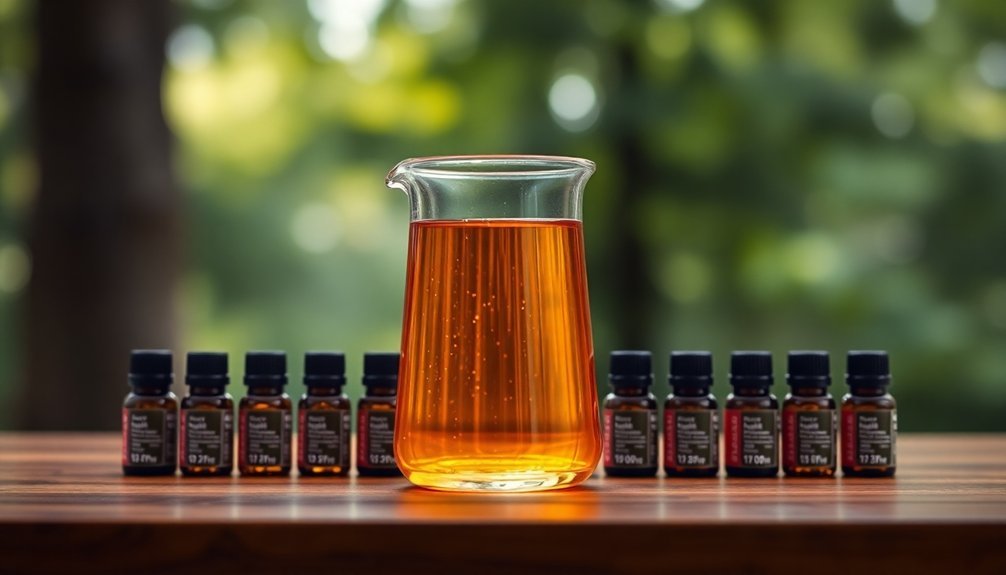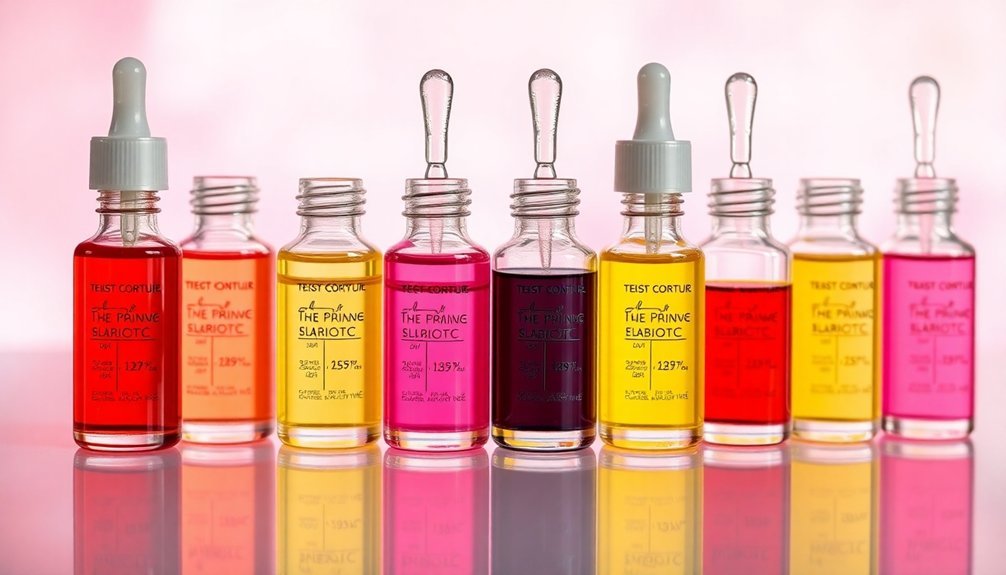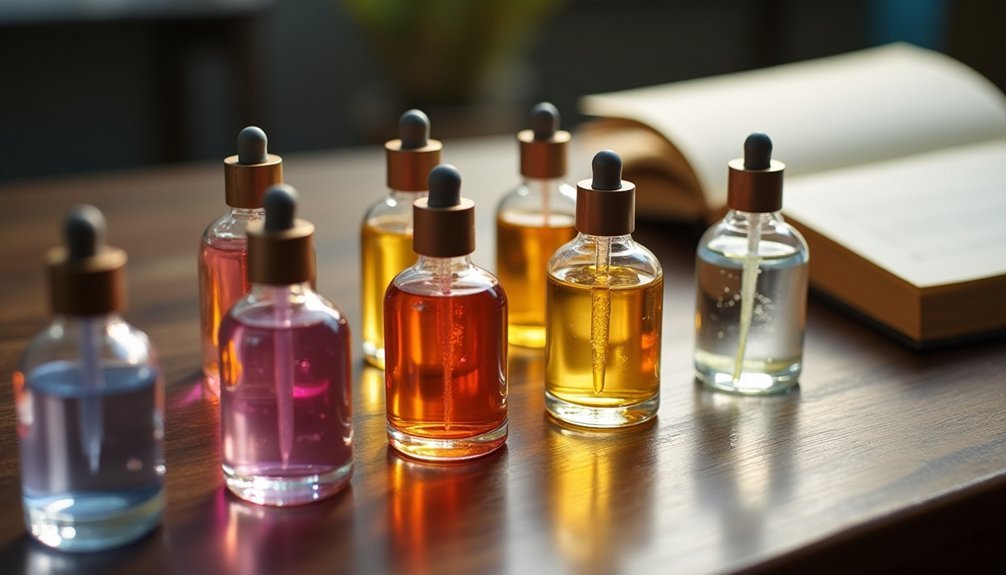Different perfume concentrations let you create your ideal signature scent. Start with parfum at 20-30% for the strongest impact, or choose eau de parfum at 15-20% for elegant balance. Eau de toilette offers a lighter touch at 5-15%, while eau de cologne (2-4%) and eau fraiche (1-3%) provide subtle freshness. You'll need precise measurements and proper tools to achieve these ratios – mastering these basics opens the door to endless fragrance possibilities.
Understanding Basic Perfume Dilution Mathematics

When working with perfume dilutions, understanding the basic mathematics is essential for achieving the right concentration and cost-effectiveness.
You'll need to master two key calculations: the dilution ratio and the X-pattern method.
To calculate dilution ratios, add the numbers together (like 1+10=11 for a 1:10 ratio), then divide your container size by this sum. For a 1000ml container, you'd need 91ml of concentrate (1000/11).
This formula works for any container size – a 500ml bottle would need 45.5ml of concentrate.
The X-pattern method helps you determine exact quantities of concentrate and diluent based on costs. Following the 30-50-20 ratio for top, middle, and base notes ensures proper fragrance structure.
You'll subtract the diluent cost from your target price to find the concentrate amount, ensuring your final product meets both quality and cost requirements.
Essential Tools for Accurate Fragrance Mixing
Since precise measurements and proper tools are crucial for perfume making, you'll need to equip yourself with essential equipment before starting any fragrance project.
Your workspace should include measurement tools like digital scales and pipettes for exact portions, along with proper storage containers and mixing equipment. Having fragrance blotters for testing scent strips will help you evaluate your perfume creations effectively.
For professional-quality results, you'll want these fundamental tools:
- Digital scales with 0.01g precision for accurate ingredient measurements
- Borosilicate glass beakers and bottles for mixing and storing your creations
- Glass stirring rods and metal spatulas for blending different consistencies
- Safety equipment including gloves, glasses, and masks to protect yourself
Don't forget to maintain cleanliness by using UV sterilization on your equipment and keeping stainless steel trays handy for surface protection while you work with your fragrances.
Common Perfume Concentration Percentages

Understanding perfume concentration levels is essential for both creating and selecting fragrances.
You'll find that parfum contains the highest concentration at 20-30%, offering up to 8 hours of strong projection.
Eau de parfum follows with 15-20% concentration, lasting 4-6 hours and providing excellent everyday wear. The complex formulations typically include 30 to 60 ingredients to create a balanced scent profile.
If you're looking for something lighter, eau de toilette contains 5-15% fragrance oils and lasts 3-5 hours.
It's a popular choice that balances performance with affordability.
For the lightest options, you'll want to take into account eau de cologne with 2-4% concentration or eau fraiche at 1-3%.
These lighter formulations are perfect for sensitive skin and warm weather, though they'll need more frequent reapplication due to their 2-hour longevity.
Step-by-Step Dilution Ratio Calculations
Three key steps guarantee accurate perfume dilution calculations: determining your target concentration, measuring your ingredients precisely, and calculating the correct ratios.
You'll need to decide whether you're aiming for a perfume (20%), EDP (15%), EDT (10%), or EDC (5%) concentration.
- Use a pipette to measure fragrance oils accurately, ensuring precise volume control.
- Calculate your alcohol volume by subtracting the fragrance percentage from 100%.
- Consider using carrier oils instead of alcohol, maintaining a 20:80 ratio.
- Double-check all measurements before mixing to avoid costly mistakes.
When working with essential oils, start by blending them before adding your carrier solution.
Remember that some materials require special dilution ratios – like vanillin at 1% or synthetic civet at 0.1%.
Always document your calculations in a spreadsheet to maintain consistency in future batches.
Safety Guidelines for Fragrance Dilutions

While precise measurements form the foundation of perfume creation, safety protocols must guide every step of the dilution process.
You'll need to keep your dilutions within recommended ranges: 5-10% for Eau de Toilette, 10-20% for Eau de Parfum, and 15-30% for Extrait. Never exceed 10% for daily-use essential oil blends.
For accuracy, always use a scale instead of drop counting. If you're working with essential oils, you must dilute them properly to prevent skin sensitization.
Remember that essential oils aren't water-soluble without an emulsifier, so choose appropriate carriers like perfumer's alcohol or DPG.
Before applying any fragrance to your skin, conduct a patch test, especially if you're pregnant, elderly, or creating products for children.
Frequently Asked Questions
Can I Mix Different Dilutions of the Same Material in One Blend?
Yes, you can mix different dilutions of the same material in your blend. You'll need to carefully calculate the final concentration and guarantee accurate proportions using a spreadsheet to track each addition.
How Long Do Properly Diluted Fragrance Materials Typically Last Before Expiring?
Your properly diluted fragrance materials can last 1-2 years if you store them correctly. Keep them in dark glass bottles, away from heat and light, and you'll maximize their shelf life.
Should Essential Oils and Synthetic Materials Be Diluted Using Different Methods?
Yes, you'll need different dilution methods: use carrier oils for essential oils to protect your skin, while synthetic fragrances work better with perfumer's alcohol, which helps stabilize and extend their scent.
What Signs Indicate That a Diluted Fragrance Material Has Gone Bad?
You'll notice your diluted fragrance has spoiled when there's a sour smell, visible sediment, significant color changes, or unusual cloudiness. The scent may also become weaker or develop an unpleasant metallic note.
Can Temperature Changes Affect the Accuracy of My Perfume Dilutions?
Yes, temperature changes can affect your dilution accuracy. You'll notice your alcohol evaporating faster in heat, which concentrates your mixture, while cold temperatures can cause separation and crystallization of fragrance components.
In Summary
You're now equipped to create your own signature scent using proper dilution ratios. Remember to always measure carefully, store your materials safely, and keep detailed notes of your formulations. Start with small batches as you perfect your ratios, and don't be afraid to experiment within safe concentration ranges. With practice and patience, you'll master the art of fragrance dilution and craft unique personal perfumes.





Leave a Reply